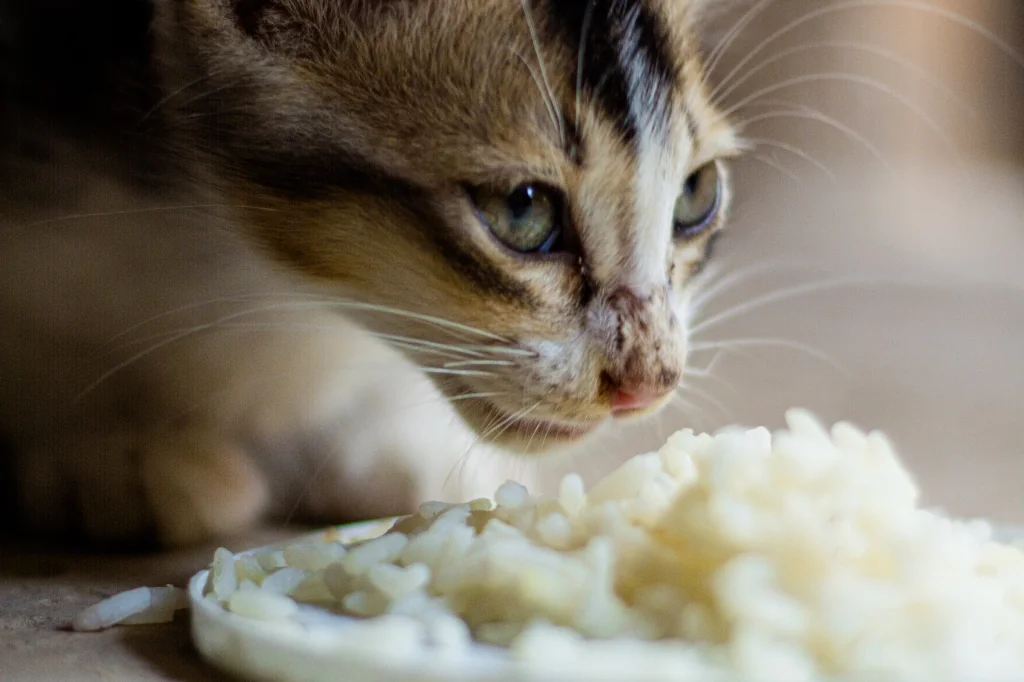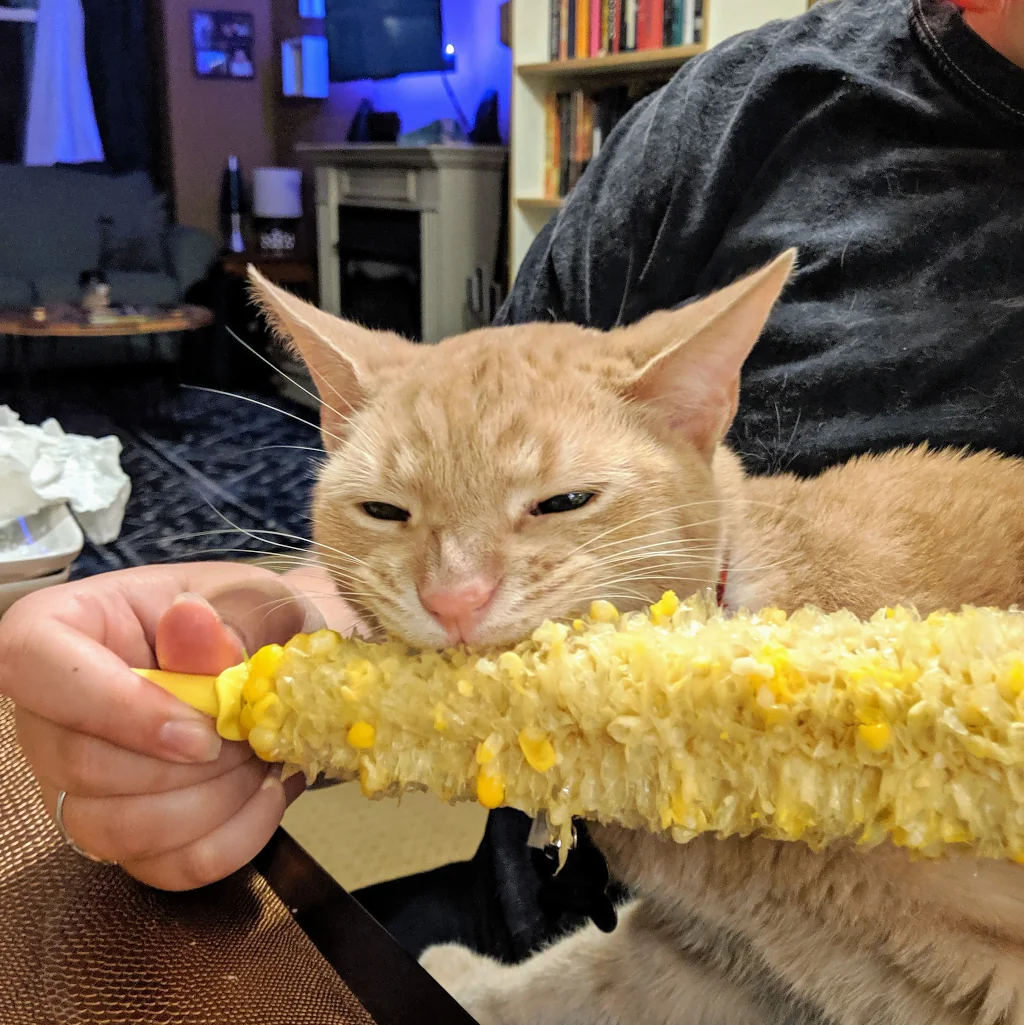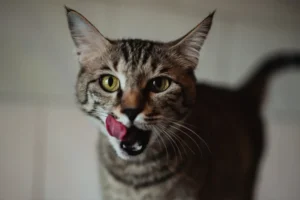Disclosure: We may earn a commission from helpful, relevant links in our content. No cost to you. See our privacy policy.
You just caught your tabby red-pawed, munching on a piece of your dropped bread, right?
The sight may bring up a common, but crucial question among cat owners: are carbs necessary for cats? And if so, how much?
You see, cats and carbs share a somewhat complex relationship, unlike humans, where carbs are considered essential. So let’s dive right in, not just to answer your burning question, but also to arm you with a full guide on the role of carbohydrates in your feline friend’s diet.
If you’ve been feeling unsure about your cat’s carbohydrate intake, then trust me, you’re at the right place.

Do Cats Really Need Carbohydrates?
As a cat owner, it’s normal to be intrigued by your furry friend’s nutritional needs.
Cats, being obligate carnivores, primarily need protein and fat. Yet, the inclusion of carbs isn’t entirely off the table.
Scientifically speaking, cats don’t require carbohydrates to survive. However, certain carbohydrates, in the right proportions, can be a beneficial addition to their diet. For example, they can provide additional energy and contribute to gastrointestinal health.
Remember, it’s about maintaining a balance, as we’ll soon show in this blog post.
What’s the Role of Carbs in Your Cat’s Health?
Having established that cats don’t necessarily need carbs, but can benefit from them, let’s explore how.
Carbohydrates, when broken down in the body, turn into glucose, a significant energy source. While cats usually derive their energy from proteins, having a little carbohydrate-derived glucose can help them meet their energy needs without using up vital proteins.
Furthermore, certain dietary fibers (a type of carb) aid digestion and help control weight. However, it’s vital to ensure these carbs are easily digestible and not added just as fillers in your cat’s diet.
For instance, beet pulp and chicory root are types of dietary fiber that are easily digestible and beneficial to your cat’s gut health. However, other fibers such as corn and wheat are often used as fillers in cat food, which can be hard for cats to digest and offer less nutritional value.
Now, let’s move on to discussing the good and the bad when it comes to carbs.
Good Carbs vs Bad Carbs for Your Cat
Now, when we’re talking about carbs in a cat’s diet, it’s essential to differentiate between the good and the bad.
The ‘good’ ones typically include complex carbohydrates, such as those found in vegetables and certain grains like oats and brown rice. They are low in calories, high in fiber, and are digested slowly, providing a steady source of energy.
On the other hand, ‘bad’ carbohydrates are the simple ones, like those found in sugary foods or refined grains. These get digested quickly, causing a sudden spike in blood sugar levels, and can lead to obesity and diabetes in cats.
The trick is to find cat foods or treats that contain beneficial carbs, and avoid those laden with unhealthy, simple carbs like corn syrup or white flour.

How Much Carbs Should You Give to Your Cat?
Determining the right amount of carbs for your feline friend isn’t as straightforward as you might think. Cats are unique individuals with different nutritional needs based on their age, weight, activity level, and overall health.
As a general rule of thumb, the cat’s diet should be high in animal-based proteins and fats, with carbs making up a small proportion.
Most feline nutritionists agree that dry cat foods should contain no more than 10% carbs on a dry matter basis, while canned foods, which have a higher water content, can go a bit higher.
Here’s a practical example to get that 10% carbohydrate intake: If you’re serving a mixed meal with 100g of home-cooked chicken and 20g of commercial dry cat food (assuming it contains about 50% carbs), the total carbohydrate contribution would be around 10g, fitting into the 10% carb guideline. However, it’s always recommended to consult your vet to account for your cat’s specific needs.
It’s crucial to note here that a cat’s carbohydrate needs can change over time, especially if they have health issues like diabetes or obesity. In such cases, a consultation with a vet is always the safest course of action.
Calculator for Cat’s Daily Carbohydrate Needs
Estimate your cat’s daily carbohydrate needs based on their weight using our simple calculator. Just enter your cat’s weight in pounds and click “Calculate”.
Enter your cat’s weight (in pounds):
? Note: This calculator estimates the carbohydrate needs of cats at a healthy weight. If your cat is overweight, feeding them based on their current weight could lead to overfeeding. Instead, use their target weight, which is the weight they would be at a healthy size.
How Many Carbs Should Be in Store-Bought Cat Food?
In store-bought cat food, dry food often contains 20% to 60% carbohydrates on a dry matter basis, but a healthier choice is aiming for a product that contains closer to 10%. Wet foods, on the other hand, usually contain fewer carbs due to their higher moisture content.
Brands such as Purina Beyond Grain-Free and Wellness Core Natural Grain Free are known for their high protein and lower carbohydrate content
Always choose a brand that prioritizes high-quality protein and fat sources above carbs.
Interpreting Cat Food Labels
When looking at cat food labels, pay attention to the following:
Ingredient list
This is a list of everything that’s in the food, listed in order of weight. This list starts with the ingredient that weighs the most. A high-quality protein source should be at the top of the list.
This source should ideally be a specific type of meat, like chicken, beef, or fish. Generic terms like “meat,” “animal by-product,” or “poultry” are less desirable as they can be any kind of meat and are often a sign of lower-quality food.
Guaranteed Analysis
This is a section on a pet food label that provides the minimum or maximum levels of nutrients such as protein, fat, fiber, and moisture. It’s a common feature on pet food labels in many countries, including the US. It provides a way to compare nutrient profiles of different pet foods.
The carbohydrate content isn’t usually listed, but you can estimate it by subtracting the percentages of crude protein, fat, fiber, moisture, and ash (if provided) from 100%. Remember, we’re aiming for cat food with around 10% carbohydrates.
Nutritional Adequacy Statement
This statement indicates if the food is complete and balanced for a specific life stage according to AAFCO (Association of American Feed Control Officials) guidelines.
Look for statements like “complete and balanced” or “formulated to meet the nutritional levels established by the AAFCO Cat Food Nutrient Profiles.
Suggested read: Cat Food Labels Guide
Can You Feed Your Cat a Low-Carb Diet?
Feeding your cat a low-carb diet can often be beneficial, especially when considering their natural dietary preferences. In the wild, cats are obligate carnivores, meaning their natural diet is low in carbs and high in protein. Here are some of the benefits and considerations when opting for a low-carb diet for your cat:
Benefits:
- Weight Management. Cats on low-carb diets often find it easier to maintain a healthy weight. Excess carbs can lead to weight gain, so reducing carbs can help an overweight cat slim down.
- Blood Sugar Regulation. Low-carb diets can be beneficial for cats with or at risk of diabetes, as it helps maintain steady blood sugar levels.
- Improved Digestion. Some cats struggle to digest high amounts of carbohydrates, leading to gastrointestinal issues. A diet low in carbs and high in protein is often easier for cats to digest.
Considerations:
While feeding your cat a low-carb diet can be beneficial, it’s important to consider the following:
- Quality of Food. Low-carb cat foods must still provide all the essential nutrients your cat needs, predominantly from high-quality animal-based proteins.
- Availability and Cost. Low-carb cat foods may not be as readily available in stores and could cost more than traditional cat foods.
However, remember that individual cats have different dietary needs, and what works for one may not work for another. It’s always best to consult with a vet before making significant changes to your cat’s diet.
Now, let’s look at the pros and cons of low-carb and high-carb diets in a table for easier comparison.
| High-Carb Diet | Low-Carb Diet | |
|---|---|---|
| Pros | Convenience: High availability and variety of commercial food. Some cats may prefer the taste. | Better aligns with cats’ natural dietary habits. Can aid in weight management and blood sugar regulation. |
| Cons | Can lead to weight gain and potential health issues like diabetes if not carefully managed. Not all cats digest carbs well. | Can be more challenging to find commercial cat food that’s low in carbs. Potentially higher cost. |
FAQs
Why does my cat seem to like carbs so much?
Cats might seem to enjoy carbs because they can enhance the texture and flavor of the food, although their bodies are primarily designed to metabolize proteins and fats.
Can excess carbs be harmful to cats?
Excessive carbs in a cat’s diet can lead to obesity and related health problems, such as diabetes and heart disease. While there is no definitive evidence that excess carbs might cause heart diseases in cats, it can definitely lead to obesity, which is a known risk factor for heart disease in many species.
Does wet cat food typically have fewer carbs?
Generally, wet cat food typically contains fewer carbs than dry food. The increased moisture content helps dilute the carbohydrate content, making it a suitable choice for a low-carb diet.
Why do some cat foods have grains?
Grains are often included in cat food because they provide a cheap and readily available source of energy. However, they should only constitute a small part of the diet and need to be well-cooked for optimal digestion.
Alex, a passionate animal lover, has experience in training and understanding animal behavior. As a proud pet parent to two dogs and three cats, he founded AnimalReport.net to share insights from animal experts and expand his knowledge of the animal kingdom.




